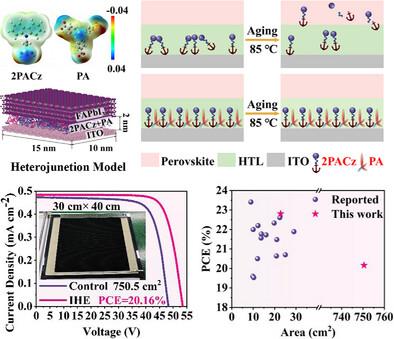Interfacial Hybrid Engineering Strategy for Highly Efficient and Stable Large-Area Perovskite Solar Modules
IF 19
1区 材料科学
Q1 CHEMISTRY, MULTIDISCIPLINARY
引用次数: 0
Abstract
Self-assembled molecules (SAMs) are considered promising materials for hole transport layers (HTL) in inverted perovskite solar cells (p-i-n PSCs). However, incomplete coverage, poor uniformity, and insufficient stability of SAM films still hinder the large-scale industrial application of SAM-based HTLs in PSCs. Here, an interfacial hybrid engineering (IHE) strategy is proposed that incorporates a molecular suppressor, 4,4,4-tris(phosphoryl) triphenylmethane (PA), to regulate SAM assembly and optimize interfacial properties. PA effectively mitigates molecular aggregation of 2-(9H-carbazol-9-yl) ethylphosphonic acid (2PACz) through steric hindrance and chemical interactions, which ensures the homogeneous distribution, well-ordered assembly, and scale-up preparation of SAM molecules. Thereby, the perovskite/HTL interface exhibits improved energy level alignment, charge extraction efficiency, and defect passivation. The champion PCE of the PA-based small-area devices is 26.55%. Large-area modules incorporating PA exhibit record-breaking efficiencies of 22.81% (22.8 cm2) and 20.16% (750.5 cm2), representing the highest performance reported for single SAM-HTL layers in scalable PSCs. Additionally, PA-modified devices demonstrate remarkable operational stability under ISOS-D and ISOS-L testing conditions. This IHE strategy provides an effective and scalable solution for achieving uniform SAM deposition in large-area PSCs while simultaneously enhancing device efficiency and long-term durability, paving the way for the commercialization of SAM-based perovskite photovoltaics.

高效稳定大面积钙钛矿太阳能组件的界面混合工程策略
自组装分子(SAMs)被认为是倒置钙钛矿太阳能电池(p-i-n PSCs)中有前途的空穴传输层(HTL)材料。然而,SAM薄膜覆盖不完全、均匀性差、稳定性不足等问题仍然阻碍了基于SAM的HTLs在psc中的大规模工业应用。本文提出了一种界面杂化工程(IHE)策略,该策略包含一个分子抑制因子4,4,4-三(磷酸基)三苯基甲烷(PA),以调节SAM组装并优化界面性能。PA通过位阻和化学相互作用有效减缓2-(9h -咔唑-9-基)乙基膦酸(2PACz)的分子聚集,保证了SAM分子的均匀分布、有序组装和规模化制备。因此,钙钛矿/ html界面表现出更好的能级排列、电荷提取效率和缺陷钝化。基于pa的小面积设备的PCE为26.55%。采用PA的大面积模块的效率分别为22.81% (22.8 cm2)和20.16% (750.5 cm2),这是可扩展psc中单个sam - html层的最高性能。此外,pa改性的器件在iso - d和iso - l测试条件下表现出显著的运行稳定性。这种IHE策略为实现大面积PSCs中均匀的SAM沉积提供了有效且可扩展的解决方案,同时提高了器件效率和长期耐用性,为基于SAM的钙钛矿光伏电池的商业化铺平了道路。
本文章由计算机程序翻译,如有差异,请以英文原文为准。
求助全文
约1分钟内获得全文
求助全文
来源期刊

Advanced Functional Materials
工程技术-材料科学:综合
CiteScore
29.50
自引率
4.20%
发文量
2086
审稿时长
2.1 months
期刊介绍:
Firmly established as a top-tier materials science journal, Advanced Functional Materials reports breakthrough research in all aspects of materials science, including nanotechnology, chemistry, physics, and biology every week.
Advanced Functional Materials is known for its rapid and fair peer review, quality content, and high impact, making it the first choice of the international materials science community.
 求助内容:
求助内容: 应助结果提醒方式:
应助结果提醒方式:


